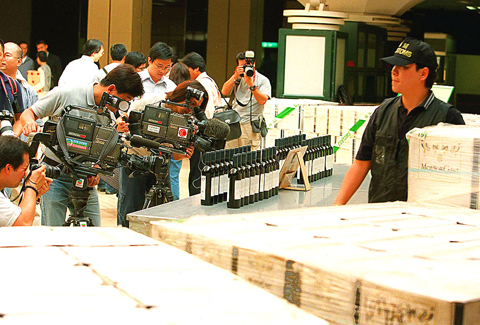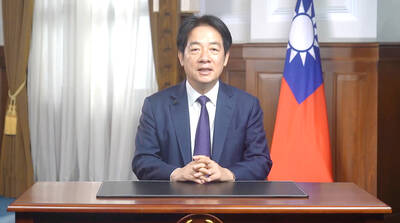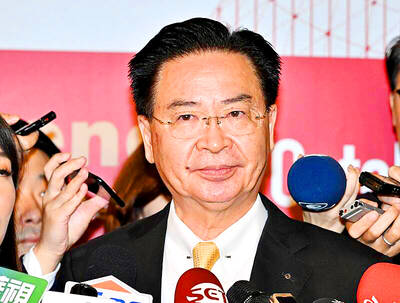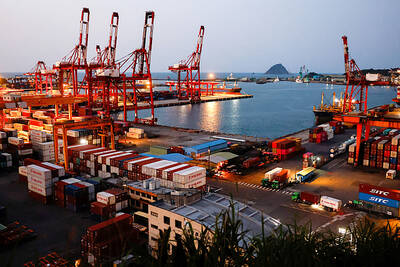Petrus, Romanee-Conti, Chateau d’Yquem — wines coveted by connoisseurs, and targeted by counterfeiters.
French wine professionals say a handful of rare and fine wines face the same threat from fraud as luxury handbags and designer sunglasses.
Trafficking in fake wine has “always existed a little, but it’s definitely amplified with the rising prices of fine wines,” said Sylvain Boivert, director of the association representing Bordeaux wines classified back in 1855, the Conseil des Grands Crus Classes en 1855.

PHOTO: AFP WARNING: EXCESSIVE CONSUMPTION OF ALCOHOL CAN DAMAGE
To the relief of many, the fakery remains on a small scale.
“We are not dealing with industrial counterfeit production, unlike the luxury brands,” he said.
The counterfeiting “touches five to six of the very top wine estates in Bordeaux where there is a real potential to make a capital gain and where there is a worldwide demand because the products are rare,” said wine tycoon Bernard Magrez, owner of 35 estates, including several in Bordeaux.
Nor have Bordeaux’s rarefied cousins in Burgundy been spared, notably Romanee-Conti, one of the world’s most expensive wines.
Jeroboams, the equivalent of four bottles, of the 1945 vintage from this 1.8 hectare estate have recently been sold in auctions, said Laurent Ponsot, a renowned Burgundy producer.
Alas, Romanee-Conti did not bottle their 1945 in jeroboams.
Ponsot, owner of Domaine Ponsot, has had his own misadventures with counterfeiters.
At a sale in New York last year, the vintner was shocked to discover that “106 bottles out of 107” were fakes. The catalogue listed “a sale of Clos Saint Denis 1945 and other old vintages when we didn’t even begin producing this particular appellation until 1982,” he said.
“The counterfeiters aren’t Asian, they are European or American,” said Ponsot, who had to fly to New York to stop the sale.
The methods used to fool buyers are only limited by the imagination of the counterfeiters: photocopied labels, different chateaux names on the capsule and the label, to name a few.
Sometimes the bottle is authentic but doesn’t contain the wine or the vintage indicated, or only partially.
“The further one is from the original market, the cruder the fakes,” said Angelique de Lencquesaing, founder of the Internet auction Web site IdealWine.
Magrez said that counterfeiting increased “when Russians began consuming after the fall of the Wall … There was an enormous temptation, because of the considerable demand.”
Add to that the immense Chinese market. While the problem of counterfeit wine remains “very anecdotal” on the French market, it “could take on a much more serious amplitude in Asia because the market is developing at a dazzling speed,” de Lencquesaing said.
China is “the principal counterfeiter,” according to Renaud Gaillard, deputy director of the French export trade body, Federation des Exportateurs de Vins et Spiritueux de France.
While the main targets are champagne and cognac, Gaillard said, “One can find Petrus and Margaux in some little stores” in China.
In addition to export markets and Internet marketplaces, fake wines slip into circulation through the auctions.
“The auction houses are not always as demanding as they should be,” said David Ridgeway, chief sommelier at legendary Paris restaurant La Tour d’Argent.
For example, “Romanee-Conti 1945, we know there were only 600 [bottles] produced. But I don’t know how many thousands of bottles we have seen at the sales,” he said.
Unlike luxury goods groups such as LVMH, which have the financial power to fight aggressively against fake goods, most vintners don’t.
“There are no funds. Each lawsuit costs 500,000 euros [US$750,000],” Ponsot said. “Vuitton has the means. The vintner, even if he sells all of his merchandise, it’s small-scale” production.
There are also those vintners who prefer to avoid any publicity regarding fake wine.
“They file a complaint, but always quietly,” French wine expert Claude Maratier said. “They are too afraid that their entire production will be put in doubt.”

US President Donald Trump yesterday announced sweeping "reciprocal tariffs" on US trading partners, including a 32 percent tax on goods from Taiwan that is set to take effect on Wednesday. At a Rose Garden event, Trump declared a 10 percent baseline tax on imports from all countries, with the White House saying it would take effect on Saturday. Countries with larger trade surpluses with the US would face higher duties beginning on Wednesday, including Taiwan (32 percent), China (34 percent), Japan (24 percent), South Korea (25 percent), Vietnam (46 percent) and Thailand (36 percent). Canada and Mexico, the two largest US trading

ACTION PLAN: Taiwan would expand procurement from the US and encourage more companies to invest in the US to deepen bilateral cooperation, Lai said The government would not impose reciprocal tariffs in retaliation against US levies, President William Lai (賴清德) said yesterday, as he announced five strategies to address the issue, including pledging to increase Taiwanese companies’ investments in the US. Lai has in the past few days met with administrative and national security officials, as well as representatives from various industries, to explore countermeasures after US President Donald Trump on Wednesday last week announced a 32 percent duty on Taiwanese imports. In a video released yesterday evening, Lai said that Taiwan would not retaliate against the US with higher tariffs and Taiwanese companies’ commitments to

‘SPECIAL CHANNEL’: Taipei’s most important tasks are to stabilize industries affected by Trump’s trade tariffs and keep negotiations with Washington open, a source said National Security Council Secretary-General Joseph Wu (吳釗燮) arrived in the US for talks with US President Donald Trump’s administration, a source familiar with the matter said on Friday. Wu was leading a delegation for a meeting known as the “special channel,” the Financial Times reported earlier. It marked Trump’s first use of the channel since returning to the White House on Jan. 20. Citing a source familiar with the matter, the Financial Times reported that Minister of Foreign Affairs Lin Chia-lung (林佳龍) was also a part of the delegation. The visit came days after China concluded war games around Taiwan and amid Trump’s

CHIP EXCEPTION: An official said that an exception for Taiwanese semiconductors would have a limited effect, as most are packaged in third nations before being sold The Executive Yuan yesterday decried US President Donald Trump’s 32 percent tariff on Taiwanese goods announced hours earlier as “unfair,” saying it would lodge a representation with Washington. The Cabinet in a statement described the pledged US tariffs, expected to take effect on Wednesday next week, as “deeply unreasonable” and “highly regrettable.” Cabinet spokeswoman Michelle Lee (李慧芝) said that the government would “lodge a solemn representation” with the US Trade Representative and continue negotiating with Washington to “ensure the interests of our nation and industries.” Trump at a news conference in Washington on Wednesday announced a 10 percent baseline tariff on most goods